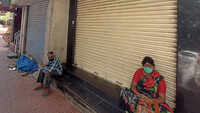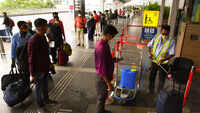
From central Delhi to Gurgaon is not too far. Barely an hour or so by car. But in 2000, the approximately 30km felt distant, psychologically if not physically. Yet we, like many before us and many after, chose to begin life anew in this then small town to the south of the Capital.
Here was a city rising out of scrub and farmland, not yet the Millennium City of ambition but an escape for harried Dilliwallas eager for release from the chokehold of smoggy air, gridlocked roads and high rents. Back then, there were more goats and donkeys than cars on the roads, and you’d often spot a pastoralist with his herd. More importantly, you could breathe without having to worry about endangering your lungs.
Power cuts were plenty, often triggered by fierce summer storms that would come out of nowhere, the more intense because they had the topography all to themselves, unhindered by glass-and-chrome office buildings, apartment towers or the ubiquitous mall.
Still, life was better. We felt healthier, in body and in mind, because we coexisted with the environment. Nature had her rhythms, we had ours, and for the most part, neither got in each other’s way.
But, so much has changed in 20 years that the Arcadia of that time feels more like a century removed than a couple of decades. Now, polluted skies, heaps of uncollected garbage, rundown infrastructure and shrinking open spaces (as Gurgaon expands ever more southwards) have become our crosses to bear.
And the once-in-a-century health emergency that is the Coronavirus has only served to highlight the parlous state of our well-being, urban and civic, environmental and personal. It has come to be this way because over time, too many diverted their eyes from what was happening all around, and allowed concrete to colonise lake, wetland and forest. We became preoccupied with creating a Singapore but elected to ignore the administrative example of the Asian city state.
Somewhere down the road, wealth became more valuable than health.
So, while the vaccine for Covid-19 might still be months away, Gurgaon can at least begin to nurse its environment back to healthiness. And her residents have an antibody within reach – community endeavour.
Reboot, restore, renew
Through late March and into April, Gurugrammers, confined to their homes, finally experienced what it meant to live without the threat of particulate matter (and other toxins) attacking their respiratory systems.
And accustomed as we are to murk and haze for much of the year, the sight of blue sky was one to behold.
The difference between the end-of-the-world gloom of post-Diwali and the cerulean skies of spring could not have been starker, especially to those who struggle to breathe (this writer included). But, could it last?
Well, that old normal, which was anyway never ‘normal’, hasn’t returned. There’s every chance it might. It all depends on whether we have the willpower to change our ways, individually and collectively.
For, if anything demonstrates the disregard for public hygiene, and the dereliction of administrative duty, it is the mountain of waste lying unattended in Bandhwari, poisoning the soil and groundwater, and fouling the air.
While city societies and RWAs have commendably led the way in segregating household waste, such initiatives have succeeded in isolation, and our city won’t be able to breathe easy – literally and metaphorically – so long as that hellish mound continues to remind us of our thoughtlessness.
Speaking of hills, the Aravallis that surround us once played the role of ecological custodian of the region. Now, stretches lie denuded of green cover, leaving flora and fauna pitted in a battle against humanity’s worst instincts. Contrary to the arguments of denialists, climate change is a reality, and the disappearing Aravalli biodiversity leaves us more exposed to dust devils and rainstorms.
Still, as wretched as it has been, 2020 offers the world the chance to press reset.
In Gurgaon, it affords us the opportunity to prove that growing the economy and nurturing the ecology can be achieved side by side. We can find a happy equilibrium and, alongside, live the Gurgaon dream.
It’s a dream realised by the elderly, who found the untouched vistas here ideal for quiet retirement. It’s a dream realised by the aspiring Indian, eager to make a life for themselves and to taste the trappings of success. It’s a dream realised by the self-made and the entrepreneurs, women and men who have transformed Gurgaon into a happy hub for startups. Each has embraced this city as home, marvelling at how it has grown (not always in the most sustainable of ways) in front of their own eyes.
Gurgaon can still be a magnet but only if we have the patience and determination to tend to it. Which means building to blend into the landscape. Designing infra that thinks less of the motorist and more of the pedestrian and cyclist. Setting aside space for parks and gardens, for the children as much as for the elders. Managing all waste – household, plastic, electronic, and construction & debris – intelligently and sensitively. And, increasing forest cover, inside and outside municipal limits, by planting more indigenous trees (as, again, communities have done on their own steam).
Crucially, we need to recognise that the future of Gurgaon is tied with the renewal of the Aravalis. If these hills revive, so will we. Because a healthy Aravali bionetwork ensures a healthy Gurgaon. And a healthy Gurgaon means less chance of folks checking out of the city.
Here was a city rising out of scrub and farmland, not yet the Millennium City of ambition but an escape for harried Dilliwallas eager for release from the chokehold of smoggy air, gridlocked roads and high rents. Back then, there were more goats and donkeys than cars on the roads, and you’d often spot a pastoralist with his herd. More importantly, you could breathe without having to worry about endangering your lungs.
Power cuts were plenty, often triggered by fierce summer storms that would come out of nowhere, the more intense because they had the topography all to themselves, unhindered by glass-and-chrome office buildings, apartment towers or the ubiquitous mall.
Still, life was better. We felt healthier, in body and in mind, because we coexisted with the environment. Nature had her rhythms, we had ours, and for the most part, neither got in each other’s way.
But, so much has changed in 20 years that the Arcadia of that time feels more like a century removed than a couple of decades. Now, polluted skies, heaps of uncollected garbage, rundown infrastructure and shrinking open spaces (as Gurgaon expands ever more southwards) have become our crosses to bear.
And the once-in-a-century health emergency that is the Coronavirus has only served to highlight the parlous state of our well-being, urban and civic, environmental and personal. It has come to be this way because over time, too many diverted their eyes from what was happening all around, and allowed concrete to colonise lake, wetland and forest. We became preoccupied with creating a Singapore but elected to ignore the administrative example of the Asian city state.
Somewhere down the road, wealth became more valuable than health.
So, while the vaccine for Covid-19 might still be months away, Gurgaon can at least begin to nurse its environment back to healthiness. And her residents have an antibody within reach – community endeavour.
Reboot, restore, renew
Through late March and into April, Gurugrammers, confined to their homes, finally experienced what it meant to live without the threat of particulate matter (and other toxins) attacking their respiratory systems.
And accustomed as we are to murk and haze for much of the year, the sight of blue sky was one to behold.
The difference between the end-of-the-world gloom of post-Diwali and the cerulean skies of spring could not have been starker, especially to those who struggle to breathe (this writer included). But, could it last?
Well, that old normal, which was anyway never ‘normal’, hasn’t returned. There’s every chance it might. It all depends on whether we have the willpower to change our ways, individually and collectively.
For, if anything demonstrates the disregard for public hygiene, and the dereliction of administrative duty, it is the mountain of waste lying unattended in Bandhwari, poisoning the soil and groundwater, and fouling the air.
While city societies and RWAs have commendably led the way in segregating household waste, such initiatives have succeeded in isolation, and our city won’t be able to breathe easy – literally and metaphorically – so long as that hellish mound continues to remind us of our thoughtlessness.
Speaking of hills, the Aravallis that surround us once played the role of ecological custodian of the region. Now, stretches lie denuded of green cover, leaving flora and fauna pitted in a battle against humanity’s worst instincts. Contrary to the arguments of denialists, climate change is a reality, and the disappearing Aravalli biodiversity leaves us more exposed to dust devils and rainstorms.
Still, as wretched as it has been, 2020 offers the world the chance to press reset.
In Gurgaon, it affords us the opportunity to prove that growing the economy and nurturing the ecology can be achieved side by side. We can find a happy equilibrium and, alongside, live the Gurgaon dream.
It’s a dream realised by the elderly, who found the untouched vistas here ideal for quiet retirement. It’s a dream realised by the aspiring Indian, eager to make a life for themselves and to taste the trappings of success. It’s a dream realised by the self-made and the entrepreneurs, women and men who have transformed Gurgaon into a happy hub for startups. Each has embraced this city as home, marvelling at how it has grown (not always in the most sustainable of ways) in front of their own eyes.
Gurgaon can still be a magnet but only if we have the patience and determination to tend to it. Which means building to blend into the landscape. Designing infra that thinks less of the motorist and more of the pedestrian and cyclist. Setting aside space for parks and gardens, for the children as much as for the elders. Managing all waste – household, plastic, electronic, and construction & debris – intelligently and sensitively. And, increasing forest cover, inside and outside municipal limits, by planting more indigenous trees (as, again, communities have done on their own steam).
Crucially, we need to recognise that the future of Gurgaon is tied with the renewal of the Aravalis. If these hills revive, so will we. Because a healthy Aravali bionetwork ensures a healthy Gurgaon. And a healthy Gurgaon means less chance of folks checking out of the city.

Coronavirus outbreak
Trending Topics
LATEST VIDEOS
City
 Shocking: Son bangs on the doors of a hospital in UP, but no one opens the door; accident victim dies
Shocking: Son bangs on the doors of a hospital in UP, but no one opens the door; accident victim dies  Covid-19 crisis: Complete lockdown from Saturday 8pm to 5am on Monday in Bengaluru
Covid-19 crisis: Complete lockdown from Saturday 8pm to 5am on Monday in Bengaluru  Pune man dons mask made of gold worth almost Rs 3 lakh
Pune man dons mask made of gold worth almost Rs 3 lakh  Covid-19: Kolkata stops flights from six major cities including Delhi between July 6 and 19
Covid-19: Kolkata stops flights from six major cities including Delhi between July 6 and 19
More from TOI
Navbharat Times
Featured Today in Travel
Quick Links
Kerala Coronavirus Helpline NumberHaryana Coronavirus Helpline NumberUP Coronavirus Helpline NumberBareilly NewsBhopal NewsCoronavirus in DelhiCoronavirus in HyderabadCoronavirus in IndiaCoronavirus symptomsCoronavirusRajasthan Coronavirus Helpline NumberAditya ThackerayShiv SenaFire in MumbaiAP Coronavirus Helpline NumberArvind KejriwalJammu Kashmir Coronavirus Helpline NumberSrinagar encounter
Get the app



